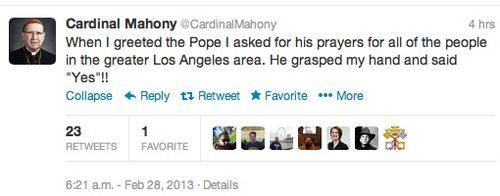David Meerman Scott's Blog, page 76
March 20, 2013
Tumi shows great customer service is excellent marketing
 It is rare that I have a customer service experience where I go "Wow!"
It is rare that I have a customer service experience where I go "Wow!"
Tumi, the travel bag company, just caused me to do so.
After many years of going through travel bag after travel bag, I decided to buy a good quality one and after some online research I invested in a Tumi Frequent Traveller in July 2009. At $600 these things are a not cheap.
I figure based on my speaking calendar alone I put nearly a million air miles on the bag since then and together we've visited some 25 countries. The bag is clearly well used, with scuffs and dirt and scars from its adventures around the world.
I didn't have any trouble with the bag for nearly four years, which is much longer than any other bag I've owned. Already it had paid for itself.
So when the retracting handle broke, I figured it was time for a new one. I wondered if it could be fixed. Probably not, I thought, but it was worth a shot.
Great customer service like that from Tumi is excellent marketing
 Thinking that I'd need to purchase a new Tumi (a million miles is more than "normal wear and tear" isn't it?) I went on Sunday afternoon to the Tumi retail store at Boston's Copley Place. Charissa took one look at the bag and said she could fix it by installing a new handle mechanism "but it would take a few days."
Thinking that I'd need to purchase a new Tumi (a million miles is more than "normal wear and tear" isn't it?) I went on Sunday afternoon to the Tumi retail store at Boston's Copley Place. Charissa took one look at the bag and said she could fix it by installing a new handle mechanism "but it would take a few days."
Cool, I thought. "Please do!"
Since I wasn't able to go back to the store to pick it up, I offered to pay to have it shipped to my home.
She wouldn’t hear of it and said they would send it back to me at no cost.
Yesterday afternoon, less than 48 hours after I left the bag at the Tumi shop, UPS delivered the repaired bag to my door.
Wow!
The new handle works like a charm.
I went into the store expecting to replace the bag that served me well for four years. Instead, at no charge, it was repaired. Remarkable.
And here I am telling you.
In a world where most companies are only interested in today's transaction, great customer service like that from Tumi is excellent marketing. Some day when my bag is finally beyond repair, I'll buy another Tumi. I'm a customer for life.
And maybe you will be a Tumi customer too after hearing my story.
Or better yet, maybe you'll look at your own customer service to see how you can turn it into excellent marketing.
March 19, 2013
Join me on an Antarctica Expedition
I'm going with Quark Expeditions on their Dec 10 - Dec 20, 2013 Antarctica expedition aboard the luxury Ocean Diamond and I am hopeful that a few adventurous travelers will want to join me!
Here is a very short video that gives you a glimpse of what we will do:
Link to Explore Our Frozen Planet with Quark Expeditions on YouTube.
Why Antarctica?
Ever since I was a child, I've always dreamed of visiting Antarctica. The idea of the white continent with no indigenous population at the bottom of the world makes me want to experience it for myself.
The scenery seems dazzling, with icebergs, mountains, and amazing animals like penguins and seals that don't fear humans. The 7th continent is a special place that fewer than 50,000 people per year will visit. I have always wanted to be one of them!
Antarctica is threatened due to climate change and there is a role for marketing and social media to communicate what's happening in one of the most stunning places on earth. I want to experience the continent firsthand so I can share my experiences and in a tiny way help keep the continent pristine for future generations.
I would like to experience Antarctica with like-minded people. If you're reading this, that means you! This is a trip to be shared. There are a few cabins available on the journey and I hope you will consider going.
What will we do on our journey to the bottom of the earth?
We depart from the southernmost city in the world, Ushuaia, Argentina (which is interesting in itself), cross the Drake Passage, and then explore the Antarctic Peninsula for a week.
During our expedition, we will live aboard the luxurious Ocean Diamond - with its comfortable cabins, great food, Internet connections(!) and a well-stocked bar(!!) - we will certainly not be roughing it.
There are daily adventures, usually by Zodiac to see penguins, icebergs, and other interesting things. We may have a chance to visit one of the research stations.
For the adventurous there will be opportunities to Sea-kayak and hike and if you're a little "out there", join me camping for one night and in the famous Quark Polar Plunge.
The ship includes experts on Antarctica and its wildlife and there will be guided trips from the ship as will as lectures in the evenings.
What about marketing and PR?
I am hopeful that a handful of explorers interested in the intersection of Antarctica and marketing will want to come along on the journey.
A maximum of 189 passengers will be aboard the ship and since the ship is filling fast, most of the passengers will not be part of our intrepid little group. We'll have plenty of time to get to know one another and dig into ideas about marketing and social media over meals and at the bar. Things are very, very informal onboard the ship and we will be free to do what we want.
I'll be joined on the trip by my wife Yukari Watanabe Scott @YukariWatanabe who is an author and social media maven in the Japanese language. She's written several books about Twitter (among other subjects.). She’s very knowledgeable about how to use social media to get noticed in the Japanese marketplace.
At one point I'm going to be giving a talk for anyone on the ship who wants to come. It is titled When You Return North: Sharing your experiences and becoming an Antarctic Ambassador and is about how each passenger can use social media to share what they experienced and help the continent to remain unspoiled. The talk will be geared towards beginners and I'll discuss how social networks are a great way to showcase interactions with penguins, seals and whales and how we experience the natural beauty of the water, ice, and land.
While we'll "talk shop" a little, mostly we're there to have fun and learn about Antarctica.
How to book a cabin
Quark is offering us a discount which is valid for the December 10, 2013 Antarctic Explorer voyage. The discount provides 20% off suites (quote code MK52) and 15% off regular cabins (quote code MK53). They do have single cabins available but those are not discounted. With a ship this small, cabins are in limited supply. The discount expires June 30, 2013.
To book a cabin or for more information on this trip (or Antarctic travel in general), visit Quark Expeditions or call Quark’s Polar Travel Advisers at 1-888-892-0073.
If you've read this far, you must be interested. You know you want to do it, right?! Perhaps Antarctica is on your bucket list. Or perhaps as our daughter said to us “Antarctica! YOLO!”
March 13, 2013
The good times are back and marketing is fun again
 When I was a kid in the 1960s and 1970s I distinctly remember as I watched (too much) television that I enjoyed the commercials. Early on I recall a lot of breakfast cereals: Trix, Cap’n Crunch, Franken Berry, and Count Chocula (fortified with 8 essential vitamins and iron) come to mind.
When I was a kid in the 1960s and 1970s I distinctly remember as I watched (too much) television that I enjoyed the commercials. Early on I recall a lot of breakfast cereals: Trix, Cap’n Crunch, Franken Berry, and Count Chocula (fortified with 8 essential vitamins and iron) come to mind.
As I hit junior high school, I paid more attention to the heavily advertised L'eggs pantyhose (girls! "they hug you, they hold you, they never let you go"), and of course the cigarette and beer ads.
I imagine that it was fun to be a consumer products marketer in the 1960s and 1970s! Looking at it from afar and without having been there, I assume you only needed to focus on a few television networks and the biggest budgets won the war. Looking back with nostalgia, it looks exciting to be a part of the Mad Men culture, enjoying a martini and a smoke at lunch and talking shop with your agency people.
Sure, it's easy to look back to the "good old days" (especially if you are too young to actually have worked in the ad business then). It's easy to ignore the negative aspects of too much booze, sugar, and cigarettes. But still...
The reality of offline B2B marketing
I became a marketer myself in the very late 1980s. I recall my work into the 1990s and early 2000s and it wasn't so much fun. No martinis at lunch. No TV commercials.
I was a B2B marketer, typically working with challenger brands rather than market leaders. We had tiny budgets. We couldn't afford fancy agencies so we did the work ourselves.
It was often a tough slog. And while I am generally an upbeat person and find the good bits in everything I do, it was difficult to get excited about writing another white paper or proofing a product brochure. Don't even get me started on "discussing" sales leads with the VP of sales!
The good times are now!
 Today marketing is an absolute blast. B2B, B2C, nonprofit, whatever – we're having fun now.
Today marketing is an absolute blast. B2B, B2C, nonprofit, whatever – we're having fun now.
Actually communicating with customers via Twitter, LinkedIn, Facebook, Instagram, and other social networks is exciting!
How cool is it to interview a rock star in your industry and pop it onto YouTube or Vimeo!
It's thrilling that one burst of cleverness can generate more media coverage than a hundred thousand dollars of PR agency pitching!
We'll never go back the Mad Men era. But we've got our own good times and they are right now.
I predict that a decade or two from now we will look back at this era too with fond nostalgia.
Count Chocula box via the wonderful Found in Mom’s Basement blog.
Instagram pic of me with Amanda Palmer by the fun-loving Steve Garfield.
March 12, 2013
Proof that you can succeed at Newsjacking too
Several months ago I connected with Trent Silver, a young Internet entrepreneur, who wanted to test some of the ideas I talk about in my free World Wide Rave book and in my Newsjacking book.
Trent has been building Web businesses since he was a 15-year-old high school student(!!). He's 22 now.
I thought this would be a fun experiment so I waited for him to get back to me with a success. It didn't take long!
Cash for Purses
 One of Trent's businesses is Cash for Purses, where he serves as CEO. Cash for Purses finds new homes for high quality designer purses and handbags (brands like Gucci, Prada, Hermes, Chanel, etc.), generating cash for the former owners.
One of Trent's businesses is Cash for Purses, where he serves as CEO. Cash for Purses finds new homes for high quality designer purses and handbags (brands like Gucci, Prada, Hermes, Chanel, etc.), generating cash for the former owners.
In the past few days, Trent has enjoyed a barrage of press because he tied his business with cash-strapped but designer bag laden starlet Lindsay Lohan. Trent recognized that Lohan is sitting on a goldmine and doesn’t even know it! So he crafted a pitch to celebrity Web sites that cover Lohan, saying that his company would purchase her extra handbags to help her pay her bills. He even offered to donate his profits to charity.
Brilliant newsjacking
Trent understands that celebrity sites are always looking for exclusive stories, so he pitched the top sites first. Since Lohan's financial troubles have been in the news, that was his newsjacking hook. Radar ran with it: We'll Buy Your Purses, Lindsay! Company Offers Big Money For Cash-Strapped Lohan’s Leftovers.
Once the story was out, other sites started to pick up on the resulting buzz including Huffington Post: Lindsay Lohan Offered Money For Used Handbags By Fundraising Company and the Inquisitr: Lindsay Lohan’s Purses May Be Key To Financial Freedom.
Interestingly, people who read celebrity sites seem to also be people who want to sell their purses because since the story broke, Trent has received several hundred new leads from people ready to sell their designer bags.
Trent's advice
"I've found it helps to have a legitimate position to take when going to the media," Trent tells us. "I really want Lindsay Lohan to sell me her purses. I really want to donate the same value of all her bags to charity. It's not a publicity stunt, it's a real offer."
Trent is a news junkie, so he enjoys looking for something interesting in the news that he can tie his business to. "I read voraciously because I know that I have to get the word out for my businesses in a way that people will understand," he says. "I make sure I am up-to-date on what's going on in the world to see if somehow I can align my businesses in a positive, interesting way. It's definitely an art and a science."
Since Trent runs his own business, he has the luxury of being able to put the word out without getting multiple approvals from people in the organization. If you run your own business too, take his advice.
But if you work at a larger organization, don't use that as an excuse, you can still get buyoff from others to generate interest in your company and its products.
"Don't be afraid to try something different," Trent says. "Different gets noticed. If you don't get noticed, you're not doing your job."
Thanks for sharing with us, Trent. Keep up the great work and let us know about your next success.
March 5, 2013
The marketing one hundred is now the marketing ten thousand
 When I was a B2B marketing executive in the 1990s, we ran marketing "campaigns".
When I was a B2B marketing executive in the 1990s, we ran marketing "campaigns".
My team focused on a about 100 big initiatives throughout the year including a dozen trade shows where we exhibited and spoke, a monthly email newsletter, a media relations effort focused on a few dozen press releases and pitches, a few white papers, a product launch or two, and the creation of print brochures and other materials.
With maybe 100 discrete things that we did during the year, each one could be measured.
From one hundred things a year to ten thousand
Marketing has fundamentally shifted.
Rather than doing a hundred really big projects, today's marketers need to do tens of thousands of tiny things each year to be successful.
It's not about the campaign, it's about engagement.
-- Rather than a dozen trade shows to exhibit and speak at, marketers need to create a 24x7 virtual showcase on the web. We need to create tons of individual articles, photos, infographics, videos, and other content to make a site strong. That means lots of very small projects instead of a dozen big ones.
-- Your monthly email newsletter is fine. But what about a daily blog post? What about 20 or 30 daily tweets? Then you’ve got your LinkedIn, Facebook, and other social feeds.
-- A decade ago your media relations effort probably focused on a few dozen press releases and media pitch campaigns in a year. Now you can engage journalists in real-time at the precise moment they are looking for information.
As you do the ten thousand, the nature of how you measure success changes.
Are you doing the ten thousand? Or are you still focused on the hundred?
photo credit: Eva the Weaver via photopin cc
March 3, 2013
The art of asking
Most music industry executives live in the past.
Music executives obsess with how to get people to pay for music in a world of free. They obsess over radio airplay when true fans no longer learn about new music on the radio. Music label execs actively discourage people from learning about new music on YouTube because they are afraid of "free." What stupidity! On one hand they are eager to be played on the radio that few listen to. On the other they claim copyright infringement and take music off YouTube where tons of people look for new music!
Amanda Palmer has proven that "How to get people to pay for music" is the wrong question. Rather, she asks: "How do we let people pay for music."
Amanda delivered an amazing TED talk titled The art of asking which was just posted.
You don't need to be in the music business to learn from Amanda's story of success.
No matter what industry you're in, marketing today is about giving. And about asking.
Give away your content
You've got to give away your white papers and ebooks (with no registration required). Freely give your blog posts and videos and Twitter streams and Instagram images and infographics. Heck, make your full-length book totally free on Kindle and iPad and Nook and as a PDF.
The world of marketing has changed. Don't let the executives tell you to put gates on all your content. Don't obsess over traditional ROI measures. Give away your best stuff!
Then ask
The fans you build with free content will want to support you. But you've got to ask them.
Amanda Palmer has made an art of asking people to help her. She didn't make people pay for music. She asked. "When you connect with people, they want to help you," she says. Like when she asked people to fund her new record on Kickstarter and nearly 25,000 people responded with about $1.2 million.
It's not easy to ask for help because asking makes you vulnerable. Take Amanda's advice: "Give and receive fearlessly. Ask without shame."
Here is my ask
Do you need a speaker at your upcoming conference? Are you interested in personalized training for your staff? I'd like to help. Here is a short video about my customized marketing and leadership presentations. Shoot me an email to learn more.
February 28, 2013
Rebranding the Catholic Church with open dialogue
As a new Pope is chosen in the Vatican over the next weeks, one Cardinal who has been embroiled in the sex scandal that has rocked the Catholic Church has taken to social media to try to clear his name.
Cardinal Roger Mahony, who resigned as archbishop of Los Angeles following the release of personnel files documenting priest sexual abuse cases during his tenure, is taking advice from a crisis management firm, writing a blog and tweeting @CardinalMahony his thoughts.

While this is interesting, because it takes guts to put yourself out there, Mahony has yet to respond to any tweets directed at him. Instead he is practicing one-way communication rather than the dialogue that defines a successful online presence. He doesn't allow comments on his blog.
Rather than engaging with the public, he's talking to the public, which is how the church has handled the entire reputation crisis it has faced in the past years.
Rebranding the Catholic Church
When people just create a one-way broadcast stream like Mahony, particularly when the individual is tainted with scandal, it appears defensive even if the motivations aren’t.
The opportunity to elect a new Pope is an excellent opportunity for the church to rebrand. There is an ideal opportunity for a new leader to change people's perception of the institution and to earn back trust.
For centuries, the church has operated using secrecy as a weapon. But in today's always-on, real-time world this approach doesn't work so well.
Besides the new Pope himself, church leaders can truly open up, using tools like blogs and Twitter to engage the public rather than just broadcast to them.
February 25, 2013
Lies, damned lies, and marketing
Do you believe these claims?
Lose twenty pounds in a week, no exercise or diet required!
My husband is the former oil minister and I want to give you $20 million!
Of course not! Scam artists prey on the one person out of a million who do. Everyone else knows these are lies.
How about these:
And now he’s making $30,000 a month from his own web site.
We exceed your expectations.
The Service Plan covers everything.
Hmm. These statements sound a little fishy, don’t they?
What about these?
Regular price $100.
Our products are [pick one] innovative, cutting-edge, world-class.
Light.
Deluxe.
It's so easy for marketers to slip into little lies. You've got to resist those seemingly small exaggerations and half-truths that harm your brand.
The leading provider of...
Service that's second to none.
Are you telling the truth? Or is some marketer making something up? Your customers see through the smokescreen.
Your call is important to us.
We love our customers.
Thanks to Seth Godin for the nose!
(Your results may vary).
February 21, 2013
Mini newsjacking flogs a dead horse
I'm always interested in fun newsjacking examples and here's one sent to us by Mazz PR.
 Over the past week, the discovery by DNA testing of horsemeat in products sold as beef has been big news in Europe. The story broke in Ireland last month, spread quickly across Europe, and has resulted in products being pulled from supermarket shelves.
Over the past week, the discovery by DNA testing of horsemeat in products sold as beef has been big news in Europe. The story broke in Ireland last month, spread quickly across Europe, and has resulted in products being pulled from supermarket shelves.
Into the furor jumps Mini with this clever ad: "Beef. With a lot of horses hidden in it."
Newsjacking.
This example from Mini is an ad, and therefore could have come from any number of companies.
For an organization associated with the news in some way, the best way to newsjack is by creating content such as a video or blog post.
When people are talking about something in the news, how can you inject your take? Can you get people to talk about you?
February 18, 2013
Effective storytelling for business
As content takes its rightful place at the forefront of marketing, I'm seeing many marketers fail at basic storytelling.
Marketers are ineffective when they use the classic "customer testimonial" format and pop that onto their blog or make it into a video. "Here’s our product. It is great. Here are customers who say it is great. Now buy some of our product." This just doesn't hold people's attention.
How interesting would a book or movie be were it to have this plot?:
Boy meets girl.
They fall in love.
They get married.
That's what most people do with their business writing.
Effective storytelling
The best stories drip with conflict. They have a hero and sometimes a villain. There is a story arc. As a writing teacher once told me: "Writing without conflict is propaganda."
Movies and novels have these elements – the best open with conflict in the first scene, on the first page, or even the first paragraph. Usually, it's one character in conflict with others (Batman against the bad guys). Sometimes it's a character in conflict with herself ("I really shouldn't go into this bar, but...").
Example of a good storytelling TV ad
Here an example of a story driven TV ad Audi aired during the 2012 Super Bowl called "Prom". I really like this ad because it is an example of all the elements of a good story. A slightly insecure teenager is unhappy about going to the Senior Prom without a date. But when Dad lets him borrow the new Audi S6 for the night, he gains more and more confidence with every mile, arriving at the Prom a changed young man. There's a confrontation and a resolution. And it all happened in one minute. (The YouTube version of the ad has 10 million views.)
Direct link to Audi Prom on YouTube.
Example of a good storytelling blog post
For an example of a story-based blog post, check out Weather Happens – Be Prepared by Kristiana Almeida on the American Red Cross blog.
Kristiana writes about her life as a kid on Cape Cod and uses that to educate on being prepared for a blizzard. Great stuff. What does the Red Cross really want? A donation. Is a donation mentioned in this post? No.
You too can be an effective storyteller
Here are a few ideas to get you thinking about telling stories that people will want to pay attention to rather than propaganda they will ignore.
- Instead of "creating copy", think about sitting in a restaurant with friends and explaining a little about your work to them. How would you say it? How would you hold your friends' interest? Write that down.
- Rather than talking about the features and benefits of your products and services, consider how you help people to solve problems.
- Who or what is the "bad guy" in your market? Is it the big, famous company that everybody does business with but nobody really likes? Is there some silly government regulation that holds buyers back? How can you weave those into a story with conflict?
- What is the status quo? Use that as the bad guy in your story.
Bonus for reading this far: Here's how I create many of the stories of success I share in this blog, in my speeches, and in my books: I think of the story as a movie or novel and cast the people from around the world whose success I showcase as my hero and traditional offline advertising and the PR pitching approach as the villains. That's what I did in this post. Audi and the Red Cross are my heroes and the traditional customer testimonial is the villain. (Shh... don't give away my secret.)
Want more?
Several years ago I wrote a free ebook Gaijin Male Model: A Case Study in Conflict-Driven Business Writing.
If you’ve got a few minutes and want to dig deeper into using conflict in your own writing, this is a good place to start. No registration required.





